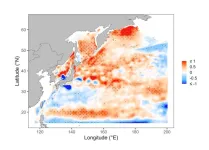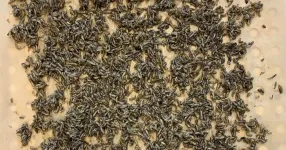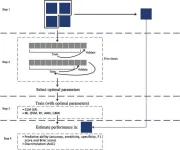(Press-News.org) Smoking cannabis associated with increased risk of heart attack, stroke
NIH-funded observational study shows risk grows sharply with more frequent use
Frequent cannabis smoking may significantly increase a person’s risk for heart attack and stroke, according to an observational study supported by the National Institutes of Health. The study, published in the Journal of the American Heart Association, uses data from nearly 435,000 American adults, and is among the largest ever to explore the relationship between cannabis and cardiovascular events.
The study, funded by the National Heart, Lung, and Blood Institute (NHLBI), part of NIH, found that daily use of cannabis — predominately through smoking — was associated with a 25% increased likelihood of heart attack and a 42% increased likelihood of stroke when compared to non-use of the drug. Less frequent use was also associated with an increased risk of cardiovascular events. Weekly users showed a 3% increased likelihood of heart attack and a 5% increased likelihood of stroke.
Around 75% of the study respondents reported that they mainly used cannabis by smoking the drug. Approximately 25% of the respondents reported using cannabis by some method other than smoking, such as vaping, drinking, or eating the drug.
“We know that toxins are released when cannabis is burned, similar to those found in tobacco smoke,” said corresponding author Abra Jeffers, Ph.D., a data analyst at Massachusetts General Hospital in Boston and formerly a researcher at the Center for Tobacco Control Research and Education at the University of California, San Francisco, where she conducted the study as part of her postdoctoral work.
“We've known for a long time that smoking tobacco is linked to heart disease, and this study is evidence that smoking cannabis appears to also be a risk factor for cardiovascular disease, which is the leading cause of death in the United States,” Jeffers said. “Cannabis use could be an important, underappreciated source of heart disease.”
Researchers note that while the exact mechanisms linking cannabis to heart disease are unclear and were not explored in the current study, multiple factors could play a role. In addition to toxins, endocannabinoid receptors — the part of cells responsible for recognizing tetrahydrocannabinol (THC), the main psychoactive ingredient in cannabis — are widespread in the body’s cardiovascular tissues and might facilitate heart risks.
Cannabis consumption has increased significantly within the past 20 years nationwide as negative perceptions of its use have declined, according to government surveys of drug use and health. In the United States, cannabis is now legal in 38 states for medicinal use and in 24 states for recreational use. Some studies have linked its regular use to impaired brain development and lung damage, as well as to certain cardiovascular diseases. However, there are gaps in knowledge about the adverse effect of cannabis on the heart.
To look more closely at associations between cannabis use and health, Jeffers and her research team used 2016–2020 data from the Behavioral Risk Factor Surveillance Survey of the Centers for Disease Control and Prevention. The national cross-sectional survey, performed annually by the CDC, included 434,104 adults ages 18-74 from 27 U.S. states and 2 territories. Most of the respondents were white (60%), while about 12% were Black, 19% Hispanic, and 9% other race/ethnicity.
The researchers evaluated the association of cannabis smoking (the number of days participants said they smoked the drug in the past 30 days) with self-reported cardiovascular outcomes, including coronary heart disease, heart attack, stroke, and a composite measure of all three. They adjusted for the participants' use of tobacco and other characteristics, including their age, sex, race, body mass index or BMI, obesity, diabetes, physical activity levels, and socioeconomic status.
“This is an important public health finding, particularly given our ongoing efforts to reduce the burden of heart disease in this country,” said David C. Goff, M.D., Ph.D., director of the NHLBI’s Division of Cardiovascular Sciences.
“Asking patients about their cannabis use during routine medical exams or physicals in much the same way they might be asked about tobacco use will help us learn more about the long term effect of marijuana on the body,” Jeffers said.
The study was funded largely by the NHLBI under grant 1R01HL130484-01A1 and included additional support from National Cancer Institute grant T32 CA113710. For a more complete funding disclosure and list of authors, please see the full JAHA research article.
Study: Jeffers, A, et al. Association of cannabis use with cardiovascular outcomes among US adults. Journal of the American Heart Association. DOI: 10.1161/JAHA.123.030178
# # #
About the National Heart, Lung, and Blood Institute (NHLBI): NHLBI is the global leader in conducting and supporting research in heart, lung, and blood diseases and sleep disorders that advances scientific knowledge, improves public health, and saves lives. For more information, visit https://www.nhlbi.nih.gov/.
About the National Institutes of Health (NIH): NIH, the nation's medical research agency, includes 27 Institutes and Centers and is a component of the U.S. Department of Health and Human Services. NIH is the primary federal agency conducting and supporting basic, clinical, and translational medical research, and is investigating the causes, treatments, and cures for both common and rare diseases. For more information about NIH and its programs, visit www.nih.gov.
NIH...Turning Discovery Into Health
END
● Simple modifications to ventilation systems improve airflow, making operations safer for both patients and surgical teams
● This research was conducted in close collaboration with a team of surgeons from Cleveland Clinic Abu Dhabi (CCAD)
Abu Dhabi, UAE, February 28, 2024: NYU Abu Dhabi (NYUAD) engineers studying ventilation systems in surgical operating theaters have found that traditional ventilation systems may inadvertently facilitate the circulation of aerosolized pathogen-carrying particles. This, as a result, puts surgical teams at a higher risk of infection by COVID-19 and other airborne diseases.
Using basic engineering tools, including ...
Fish weight in the western North Pacific Ocean dipped in the 2010s due to warmer water limiting food supplies, according to a new study at the University of Tokyo. Researchers analyzed the individual weight and overall biomass of 13 species of fish. In the 1980s and 2010s, the fish were lighter. They attributed the first period of weight loss to greater numbers of Japanese sardine, which increased competition with other species for food. During the 2010s, while the number of Japanese sardine and chub mackerel moderately increased, the effect of climate change warming the ocean appears to have resulted ...
Kelp flies and marine yeast cultivated on by-products from the seafood industry can be used in feed for farmed salmon. Replacing fishmeal and soybeans can create more sustainable and circular food production, according to a thesis from the University of Gothenburg.
Food from aquaculture, such as farmed fish, is the food industry’s fastest growing sector. One key reason is that this is a nutritious and protein-rich food that is generally more sustainably produced than protein from land animals.
However, fish farming also has challenges. One is obtaining sufficient amounts of sustainable high-quality feed. Currently, fish feed accounts for about ...
Scientists from the National Oceanography Centre (NOC) have discovered that increased meltwater in the North Atlantic can trigger a chain of events leading to hotter and drier European summers.
The paper, which will be published in the European Geosciences Union’s open access journal Weather and Climate Dynamics, suggests that European summer weather is predictable months to years in advance, due to higher levels of freshwater in the North Atlantic.
Discussing the implications, lead author Marilena Oltmanns, Research Scientist at the National Oceanography Centre, said: “While the UK and northern Europe experienced unusually cool and wet weather in Summer 2023, Greenland experienced ...
Osaka, Japan – Throughout the world, it is common for threats to national sovereignty or territorial integrity to stir up strong emotions among the public. Now, researchers from Japan have found that the strength of the reaction to such threats can break down along political lines in interesting ways.
In a study published in Peace and Conflict: Journal of Peace Psychology, researchers from Osaka University have revealed that the Japanese public is highly sensitive to what are known as “collective ownership ...
Potters of different cultural backgrounds learn new types differently, producing cultural differences even in the absence of differential cultural evolution. The Kobe University-led research has implications for how we evaluate the difference of archaeological artifacts across cultures.
Cultural artifacts differ between cultures but are relatively stable within cultures. This makes pottery, and in particular its form, an important archaeological indicator to determine the presence of different cultural groups in specific locations and how they influenced each other over time. But where do such culturally stable variations arise from? The typical explanation for this is through “selective ...
HONG KONG (28 Feb 2024) — Unique insights into the social lives of cattle revealed in a new study by scientists at City University of Hong Kong (CityUHK) can enhance our understanding of animal behaviour and welfare. The study suggests that sex and social status influence social grooming (where one animal licks another, also known as allogrooming) among free-ranging feral cattle in Hong Kong.
The CityUHK researchers found that feral cattle performed preferential grooming of certain individuals and, in particular, that more dominant females received more grooming. This asymmetrical distribution of licking also applied to whom male cattle decided to ...
Scientists have produced the first detailed estimates of how much sediment is transported onto the shores of coral reef islands, and how that might enable them to withstand the future threats posed by climate change.
Coral reef islands are low-lying accumulations of sand and gravel-sized sediment deposited on coral reef surfaces.
The sediments are derived from the broken down remains of corals and other organisms that grow on the surrounding reef. Therefore, the rate of supply of sediment from reefs is a critical control on island formation and future change.
The international team of researchers used data available for 28 reef islands in the Indian and Pacific Oceans, widely ...
Bridging precision engineering and precision medicine to create personalized physiology avatars. Pursuing on-demand tissue and organ engineering for human health. Revolutionizing neuroscience by using AI to engineer advanced brain interface systems. Engineering the immune system for health and wellness. Designing and engineering genomes for organism repurposing and genomic perturbations.
These are the five research areas where the field of biomedical engineering has the potential to achieve tremendous impact on the field of medicine, according to “Grand Challenges at the Interface of Engineering and Medicine,” a study published by a 50-person task force published ...
Submucosal tumors (SMTs) are usually found in the stomach and esophagus during an upper endoscopy. Submucosal tunneling endoscopic resection (STER) and non-tunneling endoscopic resection (NTER) are the two most commonly used techniques in the treatment of gastric and esophageal SMTs. As novel technologies continue to shape the medical landscape, machine learning (ML) algorithms find increased application, demonstrating enhanced performance in various fields. Although some studies have evaluated the incremental value of flexible ML methods, comparisons with traditional logistic regression (LR) models are lacking.
To this end, a recent study by a team of researchers from China published in the ...







